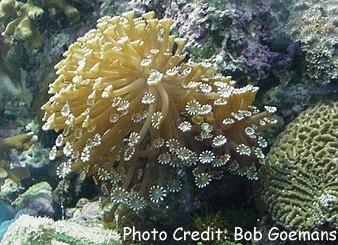
By Bob Goemans


Likely Reef Tank Suitable
Likely Fish-Only Tank Suitable
Those in the genus Alveopora are rarely seen in the trade, but one of my favorite corals. Common names of this photosynthetic coral include Ball Coral, Branching Flower Pot Coral, and Daisy Coral. Similar to Goniopora, however its polyps have 12 tentacles and Goniopora has 24, and it forms branching columns. They are normally found on exposed upper reef slopes, in protected turbid environments, and rocky foreshores. Had one specimen, A. gigas, for 7 years in a 20 gallon reef tank lit with two 9W fluorescent lamps and one very small powerhead for water circulation.
As for Goniopora species, they have long stem-like polyps that extend from either a half-moon shaped stony base or from branch-like structures. Color is usually various shades of brown, with pink and green versions occasionally showing up. Yet, there are many color combinations and no two specimens looking alike. The flower-like polyps can extend far out from the base area, with some specimens extending 18 to 24 inches (45 - 60 cm).
They are usually called "Flowerpot Corals" and many find this a somewhat difficult stony coral to maintain longterm. Yet, have maintained different species for more than three years with some hobbyists far exceeding that. Until we can resolve their exact nutritional needs, they continue to to be somewhat problematic. In my opinion, these photosynthetic corals do better in low to medium light, and seem to prefer fluorescent light rather than metal halide lamps, and gentle water movement.
Those in the Porites genus are encrusting photosynthetic corals found in many diverse areas throughout the world, however, they seem to be at their best in aquaria when given extremely good light and high energy water movement. They take many forms, e.g., bolder shape, plate-like, dome-shaped, and stout branch-like growths with blunt ends. Usually brown, yet there are some colorful versions to be found, e.g., yellow, purple, and pink. Common names include Christmas Tree Worm Rock Coral, Boulder Coral, and Encrusting Coral. Be aware there is a small Nudibranch, Phestilla lugubris that feeds upon porites coral. Should you discover discolored patches of polyps, or its tiny tentacles not extended, look closely for this tiny nudibranch and remove.